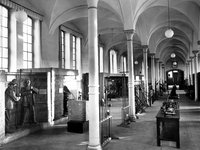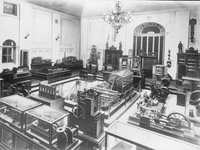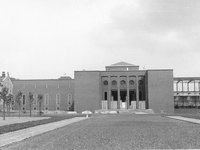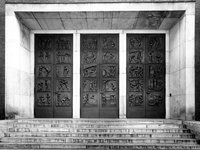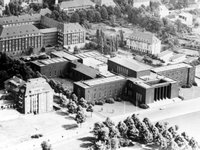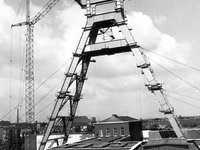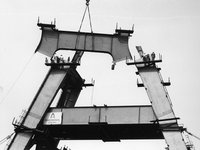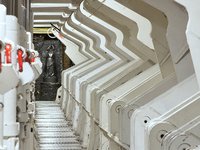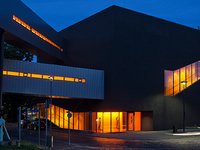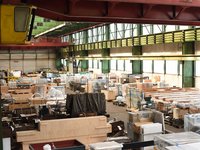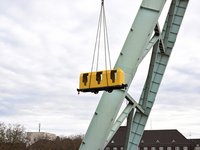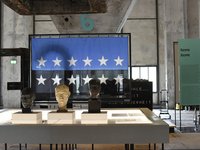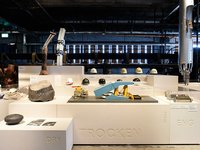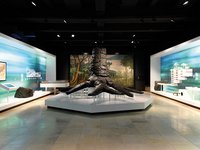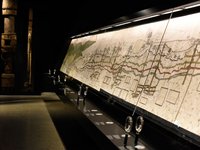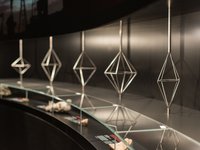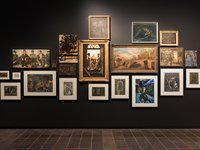History
The Deutsches Bergbau-Museum Bochum, the Leibniz Research Museum for Geo-resources, was founded on 1 April 1930. From its modest beginnings as a “Historical Mining Museum”, now almost 90 years of history behind it, it has grown to become the world's largest mining museum.
With approximately 8000 m² of exhibition space and a 2.5 km long visitor’s mine – 1.2 km of which is accessible to visitors - the museum provides insight into the numerous methods of raw material extraction. And coal is not the only mined material explored here, for there’s also salt, gold, silver, and copper as well as less common raw materials, such as lithium and molybdenum.
Research and the presentation of globally outstanding artefacts in a museum setting, enable interconnections to be highlighted between raw material extraction, its subsequent processing and the related social and cultural developments. The exploration and portrayal of mining as one of mankind’s archetypal production activities, which has all the time remained an indispensable, active sector of economy throughout the world, makes a crucial contribution to understanding the development and current status of our society and culture.
In the middle of the 19th century, mining was one of the most important economic sectors in Germany. In 1868 the Westfälische Berggewerkschaftskasse (WBK) in Bochum, the cooperative venture of the Ruhr mining industry, established a collection of “Mining tools” for teaching and exhibition purposes, to introduce young miners – not the general public – to mining technology and the nature of coal-bearing rock. Plans to found a public mining museum in Bochum were discussed, but were not implemented due to the difficult economic situation until 1927. Then, however, the city of Bochum and the WBK took the initiative, and Heinrich Winkelmann, a mining engineer who later became the museum’s first director, devised the plan of converting the former abattoir into a museum. So the museum was not built on the foundations of a former mine, as many visitors assume.
The first step was the founding of the museum on 1 April 1930 by the city of Bochum and the Westfälische Berggewerkschaftskasse. The museum was set up in the former cattle slaughterhouse, and was initially run by a director, a master model-maker, and a models custodian. It grew step by step.
The appearance of the museum today is largely shaped by the new, prestigious museum building based on plans by the renowned industrial architect Fritz Schupp. The decision to build was made in 1935. To give visitors as realistic an impression as possible of working life underground, the construction of a visitor mine was planned right from the start. At the end of June 1937 a shaft was sunk so that the first gallery could be excavated. In 1940, 600 metres of galleries and cross-cuts had already been excavated in the visitor mine, around 17 metres under the ground, and most of this had been fitted with permanent supports.
Before it was fully completed, the museum building was badly damaged by Allied air raids, and in 1943 the museum had to be closed because of the war. The few remaining members of staff moved valuable items from the collection to safe places, and converted the visitor mine into an air-raid shelter. This became the most heavily-used air-raid shelter in Bochum, with between 580 and 760 people per day seeking refuge here in 1945.
After the end of the war the first tasks were to clean up and carry out repairs, before the first small exhibition could be opened in 1946. The visitor mine was reopened to the public in 1948. In 1947 the “Vereinigung der Freunde von Kunst und Kultur im Bergbau e.V.” (“Association of friends of art and culture in mining”) was founded. This organization still actively supports the museum, vigorously promoting a number of activities associated with mining. In 1953 a new building, the “Mittelbau”, gave the Bergbau-Museum an additional 1000 m2 of exhibition space. 36 Bergwerkskassen (mine funds) donated the massive three-door bronze entrance, with 30 reliefs by the Düsseldorf artists Otto Bussmann and Maria Schlüter. In the 1950s the museum’s mining experts continued the research on mining archaeology which had been started in 1942.
Under the museum director Hans Günter Conrad, who took up his position in 1962, the historically oriented museum was expanded and reconfigured as a “research museum”, i.e. a non-university research institution with both national and regional funding. In 1969 the Bergbau-Archiv (Mining Archive) was founded. Its aim was to collect, conserve and index evidence of all kinds – written material, files and photos – from the entire German mining industry. At present it houses over 250 sets of records and just under 30 special collections, taking up over 4.5 kilometres of shelf space. The collections of the Bergbau-Archiv, the library and the Fotothek (photo library) have now been brought together in the Montanhistorisches Dokumentationszentrum (montan.dok).
In 1973 the Bergbau-Museum Bochum acquired its emblem, the former double headframe from the decommissioned “Germania” mine. 71.4 m high and weighing 650 t, the headframe is based on plans by the industrial architect Fritz Schupp. A lift was installed to connect the visitor mine, the viewing platform and the museum. By saving the headframe, the Bergbau-Museum triggered a debate about whether technological industrial sites were worth preserving as historical monuments. Since then, the conservation of technological heritage sites has been one of the museum’s research activities. To recognize its importance as a specialist technical museum within the national and international museum landscape, the Bergbau-Museum was renamed on 1 March 1976, becoming the Deutsches Bergbau-Museum Bochum.
In 1977 the Deutsches Bergbau-Museum Bochum was recognized as a research museum by the Bund-Länder-Kommission (BLK), and included in the joint national and regional research funding programme. Since then it has been one of the institutions on the “Blaue Liste” (“blue list”), now known as the Leibniz Association (Wissenschaftsgemeinschaft Gottfried Wilhelm Leibniz e.V., WGL). In 1979 the DBM was admitted to the Arbeitsgemeinschaft außeruniversitärer historischer Forschungseinrichtungen in der Bundesrepublik Deutschland (Working group of non-university historical research institutions in the Federal Republic of Germany).
In 1980 the Deutsches Bergbau-Museum Bochum celebrated its 50th anniversary. In 1986 the “Erweiterungsbau Süd” (south annex) was opened. The extension provided a further 3000 m2 for new exhibition areas, an auditorium and a seminar room, as well as the cafeteria and restaurant. Prof. Dr. Rainer Slotta, who took up the position of director in 1987, launched a series of large temporary exhibitions which have raised the museum’s national profile.
In the visitor mine, which had previously only demonstrated the workings of a hard coal mine on the Ruhr, work began on the presentation of a contemporary iron ore mine. This was inaugurated in 1987. In 2003, after a 10-year construction period, a modern longwall face was opened in the visitor mine. This made the Deutsches Bergbau-Museum Bochum the only mining museum in Germany to document the current state of technology in the hard coal mining industry. In 2005 the Deutsche Bergbau.Museum Bochum celebrated its 75th anniversary. The collections now comprise over a quarter of a million objects. In 2009 an annex with a modern architectural design, the “DBM+”, was opened. The new annex enables the museum to keep up to date by presenting timely new special exhibitions.
Since 2014, the Deutsches Bergbau-Museum Bochum has been undergoing a comprehensive structuring process within a project entitled “Master Plan DBM 2020”. It means not just the restructuring of the organisation itself, but also a comprehensive reorganisation process and the conception of a new permanent exhibition. This entails a huge logistical feat that will see the museum and its collections, library/photographic library and the Mining Archive of Bochum completely removed and relocated. Some of the staff and exhibits will move to interim sites. In future, there will be four new tours presenting the range of areas explored by the Leibniz Research Museum for Geo-resources.
2018 saw the Deutsches Bergbau-Museum and the Ruhr Museum in Essen work together for the first time on a major collaborative exhibition. “The Age of Coal. A European History”, was displayed in the mixing facility of the Zollverein coking plant.
An initial part of the new permanent exhibition concept was completed in November, at the same time as coal mining activity in Germany ended: 28 November 2018 witnessed the inauguration of the first two tours entitled “Hard Coal” and "Mining”. They tell the history of German hard coal mining and other links between mankind and mining around the world, presented across the various epochs, and by adopting a multi-disciplinary stance. Then, in the summer of 2019, the museum hosted a large-scale event celebrating the opening of the new permanent exhibition. Since July 2019, the Deutsches Bergbau-Museum Bochum, Leibniz Research Museum for Geo-resources, has run four themed tours that demonstrate the focal areas of its activities: Hard Coal, Mining, Mineral Resources, and Art.

